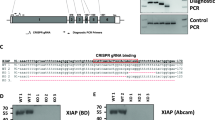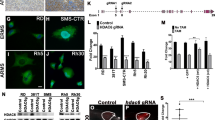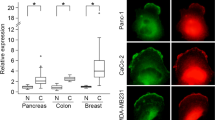Abstract
The Rho family GTPases Rac1, RhoA and Cdc42 function as molecular switches that transduce intracellular signals regulating multiple cell functions including gene expression, adhesion, migration and invasion. p53 and its regulator p19Arf, on the other hand, are tumor suppressors that are critical in regulating cell cycle progression and apoptosis. Previously, we have demonstrated that the Rho proteins contribute to the cell proliferation, gene transcription and migration phenotypes unleashed by p19Arf or p53 deletion in primary mouse embryo fibroblasts (MEFs). To further investigate their functional interaction in the present study, we have examined the involvement of Rho signaling pathways in p53-mediated cell invasion. We found that in primary MEFs (1) p53 or p19Arf deficiency led to a marked increase in the number of focal adhesion plaques and fibronectin production, and RhoA, Rac1 and Cdc42 contribute to the p53- and p19Arf-mediated focal adhesion regulation, but not fibronectin synthesis; (2) although endogenous Rac1 activity was required for the p19Arf or p53 deficiency-induced migration phenotype, hyperactive Rho GTPases could not further enhance cell migration, rather they suppressed cell–cell adhesion of p53−/− MEFs; (3) expression of the active mutant of RhoA, Rac1 or Cdc42, but not Ras, promoted an invasion phenotype of p53−/−, not p19Arf−/−, cells; (4) although ROCK activation can partially recapitulate Rho-induced invasion phenotype, multiple pathways regulated by RhoA, in addition to ROCK, are required to fully cooperate with p53 deficiency to promote cell invasion; and (5) extracellular proteases produced by the active RhoA-transduced cells are also required for the invasion phenotype of p53−/− cells. Combined with our previous observations, these results strongly suggest that mitogenic activation of Rho family GTPases can cooperate with p53 deficiency to promote primary cell invasion as well as transformation and that multiple signaling components regulated by the Rho proteins are involved in these processes.
This is a preview of subscription content, access via your institution
Access options
Subscribe to this journal
Receive 50 print issues and online access
$259.00 per year
only $5.18 per issue
Buy this article
- Purchase on Springer Link
- Instant access to full article PDF
Prices may be subject to local taxes which are calculated during checkout







Similar content being viewed by others
References
Alexandrova A, Ivanov A, Chumakov P and Vasiliev J . (2000). Oncogene, 19, 5826–5830.
Aznar S and Lacal JC . (2001). Cancer Lett., 165, 1–10.
Bar-Sagi B and Hall A . (2000). Cell, 103, 227–238.
Bernards R and Weinberg RA . (2002). Nature, 418, 823.
Bishop AL and Hall A . (2000). Biochem. J., 348, 241–255.
Boettner B and Van Aelst L . (2002). Gene, 286, 155–174.
Clark EA, Golub TR, Lander ES and Hynes RO . (2000). Nature, 406, 532–535.
Comer KA, Dennis PA, Armstrong L, Catino JJ, Kastan MB and Kumar CC . (1998). Oncogene, 16, 1299–1308.
Etienne-Manneville S and Hall A . (2002). Nature, 420, 629–635.
Fritz G, Just I and Kaina B . (1999). Int. J. Cancer, 81, 682–687.
Fujisawa K, Madaule P, Ishizaki T, Watanabe G, Bito H, Saito Y, Hall A and Narumiya S . (1998). J. Biol. Chem., 273, 18943–18949.
Gadea G, Lapasset L, Gauthier-Rouviere C and Roux P . (2002). EMBO J., 21, 2373–2382.
Gloushankova N, Ossovskaya V, Vasiliev J, Chumakov P and Kopnin B . (1997). Oncogene, 15, 2985–2989.
Guo F and Zheng Y . (2004). Mol. Cell. Biol., 24, 1426–1428.
Guo F, Gao Y, Wang L and Zheng Y . (2003a). J. Biol. Chem., 278, 14414–14419.
Hahn WC and Weinberg RA . (2002). Nat. Rev. Cancer, 2, 331–341.
Iotsova V and Stehelin D . (1996). Cell Growth Differ., 5, 629–634.
Kaibuchi K, Kuroda S, Fukata M and Nakagawa M . (1999). Curr. Opin. Cell Biol., 11, 591–596.
Kamijo T, Zindy F, Roussel MF, Quelle DE, Downing JR, Ashmun RA, Grosveld G and Sherr CJ . (1997). Cell, 91, 649–659.
Levine AJ . (1997). Cell, 88, 323–331.
Liliental J, Moon SY, Lesche R, Mamillapalli R, Gavrilova N, Zheng Y, Sun H and Wu H . (2000). Curr. Biol., 10, 401–404.
Lin R, Cerione RA and Manor D . (1999). J. Biol. Chem., 274, 23633–23641.
Mira JP, Benard V, Groffen J, Sanders LC and Knaus UG . (2000). Proc. Natl. Acad. Sci. USA, 97, 185–189.
Mukhopadhyay D, Tsiokas L and Sukhatme VP . (1995). Cancer Res., 55, 6161–6165.
Nobes C and Hall A . (1999). J. Cell Biol., 144, 1235–1245.
Preudhomme C, Roumier C, Hildebrand MP, Dallery-Prudhomme E, Lantoine D, Lai JL, Daudignon A, Adenis C, Bauters F, Fenaux P, Kerckaert JP and Galiegue-Zouitina S . (2000). Oncogene, 19, 2023–2032.
Ridley AJ . (2001). J. Cell Sci., 114, 2713–2722.
Sablina AA, Chumakov PM and Kopnin BP . (2003). J. Biol. Chem., 278, 27362–27371.
Sahai E, Alberts AS and Treisman R . (1998). EMBO J., 17, 1350–1361.
Sahai E and Marshall CJ . (2002). Nat. Rev. Cancer, 2, 133–142.
Sahai E and Marshall CJ . (2003). Nat. Cell Biol., 5, 711–719.
Schmitt CA, Fridman JS, Yang M, Baranov E, Hoffman RM and Lowe SW . (2002). Cancer Cell, 1, 289–298.
Schnelzer A, Prechtel D, Knaus U, Dehne K, Gerhard M, Graeff H, Harbeck N, Schmitt M and Lengyel E . (2000). Oncogene, 19, 3013–3020.
Schwartz MA and Shattil SJ . (2000). Trends Biochem. Sci., 25, 388–391.
Serrano M, Lin AW, McCurrach ME, Beach D and Lowe SW . (1997). Cell, 88, 593–602.
Sherr CJ . (2001). Nat. Rev. Mol. Cell. Biol., 2, 731–737.
Sun Y, Sun Y, Wenger L, Rutter JL, Brinckerhoff CE and Cheung HS . (1999). J. Biol. Chem., 274, 11535–11540.
Suwa H, Ohshio G, Imamura T, Watanabe G, Arii S, Imamura M, Narumiya S, Hiai H and Fukumoto M . (1998). Br. J. Cancer, 77, 147–152.
Van Aelst L and D'Souza-Schorey C . (1997). Genes Dev., 11, 2295–2322.
Zhao R, Gish K, Murphy M, Yin Y, Notterman D, Hoffman WH, Tom E, Mack DH and Levine AJ . (2000). Genes Dev., 14, 981–993.
Zheng Y . (2001). Trends Biochem. Sci., 26, 724–732.
Zindy F, Eischen CM, Randle DH, Kamijo T, Cleveland JL, Sherr CJ and Roussel MF . (1998). Genes Dev., 12, 2424–2433.
Zohn IM, Campbell SL, Khosravi-Far R, Rossman KL and Der CJ . (1998). Oncogene, 17, 1415–1438.
Acknowledgements
We thank Dr Martine Roussel (St Jude Children's Research Hospital) for the gifts of MEFs and Arf cDNA. This work was supported in part by a grant from National Institutes of Health (CA105117).
Author information
Authors and Affiliations
Corresponding author
Rights and permissions
About this article
Cite this article
Guo, F., Zheng, Y. Rho family GTPases cooperate with p53 deletion to promote primary mouse embryonic fibroblast cell invasion. Oncogene 23, 5577–5585 (2004). https://doi.org/10.1038/sj.onc.1207752
Received:
Revised:
Accepted:
Published:
Issue Date:
DOI: https://doi.org/10.1038/sj.onc.1207752
Keywords
This article is cited by
-
S100PBP is regulated by mutated KRAS and plays a tumour suppressor role in pancreatic cancer
Oncogene (2023)
-
Mutational drivers of cancer cell migration and invasion
British Journal of Cancer (2021)
-
VAV2 signaling promotes regenerative proliferation in both cutaneous and head and neck squamous cell carcinoma
Nature Communications (2020)
-
Therapeutic effects of statins against lung adenocarcinoma via p53 mutant-mediated apoptosis
Scientific Reports (2019)
-
The Δ133p53 isoform and its mouse analogue Δ122p53 promote invasion and metastasis involving pro-inflammatory molecules interleukin-6 and CCL2
Oncogene (2016)



